Choosing a High-Magnification Scope
6mmBR.com Scope Survey Poll Results >
Buying the right scope for precision target shooting can be very simple, or you can spend weeks agonizing over the decision. Amazingly, some people spend $850 or more on a high-end scope without ever looking through a sample first. You should carefully inspect focus, clarity, the alignment of the cross-hairs, eye relief and the exit pupil size. Buying a cheap 40-power scope is just going to make you miserable if it isn't sharp or if the exit pupil is too small. If possible, before you buy, examine scopes at a gun store or check out the scopes on your buddies' rifles. Try out the turrets, check the "feel" of the parallax adjustment, and view a variety of different reticles. You may find you have a strong preference for a particular cross-hair thickness, or you may want the ranging capability offered by Mildot and Varminter reticles.
Before purchasing a scope, you need to do your homework. Leupolds are fine scopes, for example, but a few of them have tracking problems or canted reticles that need to be fixed right out of the box, and all of the side-focus models demand that you compensate for lash. Each time you adjust focus/parallax on these scopes, you need to rotate the side knob ALL the way back to the infinity stop and then work back slowly to best target focus. Trust us, this "dial-back" procedure is straight from Leupold's engineers and we can confirm it works.
Confused about Parallax? Here's a complete Analysis of Parallax from the engineers at U.S. Optics.
Resolution: Set up a piece of newspaper at 50 yards and see how well you can read the headlines and text. If you use a weighted plumb line attached to the target frame, it helps to align your sample. Here's also a lens resolution Test Chart you can print.
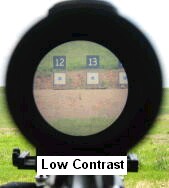
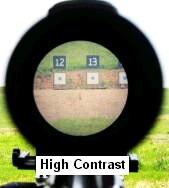 Image Contrast: Take two scopes with equal optical resolution (sharpness), and give one better image contrast and it will be better for target use. More contrast helps you resolve fine lines and pick out bullet holes better. Some scopes have excellent light transmission, but they would appear much sharper if they were tuned for better contrast. Image quality can also be improved with lens coatings that filter out UV and specific blue wavelengths that degrade perceived image sharpness.
Image Contrast: Take two scopes with equal optical resolution (sharpness), and give one better image contrast and it will be better for target use. More contrast helps you resolve fine lines and pick out bullet holes better. Some scopes have excellent light transmission, but they would appear much sharper if they were tuned for better contrast. Image quality can also be improved with lens coatings that filter out UV and specific blue wavelengths that degrade perceived image sharpness.
Eye Relief: Mount the scope on your rifle and see if you can easily view the centered full image (without vignetting) in a stable, comfortable shooting position with the butt touching your shoulder. With some scopes, excessive eye relief makes this impossible. If you're acquiring a zoom scope, check for eye relief variations as you change the magnification. A scope that offers near-constant eye relief is much easier to use in the field. You're not constantly moving your head back and forth to get a consistant image through the eyepiece. Most manufacturers publish eye relief for their scopes, but you really need to try it out yourself. Among high-magnification zoom scopes, the Burris Black Diamond 8-32x and Nightforce 8-32x BR are very good in this respect. Eye relief is 3-3.5 inches through the entire magnification range.
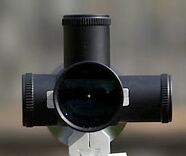 Exit Pupil: Given objectives (front lens elements) of equal size, the more magnification the scope, the smaller the exit pupil. Remember that the exit pupil, a tiny circle of light, must deliver ALL the optical data your eye receives. Bigger is better by far. Too small an exit pupil will make a good scope dim and hard to use. That's why we advise against boosting the Weaver T-36 or the 36X Sightron. With their respective 40mm and 42mm objectives, the exit pupil becomes too small when they are boosted beyond 36x. The photo is a 40x Leupold Competition scope which has a 45mm objective and a 1.13mm exit pupil.
Exit Pupil: Given objectives (front lens elements) of equal size, the more magnification the scope, the smaller the exit pupil. Remember that the exit pupil, a tiny circle of light, must deliver ALL the optical data your eye receives. Bigger is better by far. Too small an exit pupil will make a good scope dim and hard to use. That's why we advise against boosting the Weaver T-36 or the 36X Sightron. With their respective 40mm and 42mm objectives, the exit pupil becomes too small when they are boosted beyond 36x. The photo is a 40x Leupold Competition scope which has a 45mm objective and a 1.13mm exit pupil.
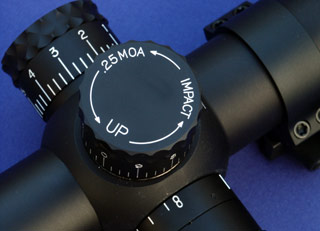 Tracking: No scope, no matter how expensive, is good for competition if the cross-hairs change position from shot to shot, or if the elevation and windage adjustments are not repeatable. When you buy a scope you should immediately do a "box-test" to confirm the scope's repeatability. Fire one shot, then crank in 6moa up, fire another shot, add 6moa right, fire the third shot. Then crank 6moa down elevation and fire the fourth. Finally add 6moa left windage and fire your last shot. If the scope is working right, the fifth and final shot should be right on top of the first (assuming no wind shifts).
Tracking: No scope, no matter how expensive, is good for competition if the cross-hairs change position from shot to shot, or if the elevation and windage adjustments are not repeatable. When you buy a scope you should immediately do a "box-test" to confirm the scope's repeatability. Fire one shot, then crank in 6moa up, fire another shot, add 6moa right, fire the third shot. Then crank 6moa down elevation and fire the fourth. Finally add 6moa left windage and fire your last shot. If the scope is working right, the fifth and final shot should be right on top of the first (assuming no wind shifts).
Note, best prices on most of the scopes listed below are found at SWFA.com, and TheOpticZone.com. Contact Bill Shehane, D & B Supply, for good deals on Nightforce Scopes. Grafs.com also has very good prices if you have a business license or C&R license and can qualify for the "dealer discount."
| Scope |
Rating |
Power |
Size |
Weight |
Obj. Diam. |
Exit Pupil |
Click MOA |
Elev. MOA |
Low Price |
| B&L 4000 |
**** |
36x |
1 inch 15.2" L |
18 oz |
42mm |
1.16mm |
1/8 |
34 |
$350 used |
| Burris Black Diamond |
*** |
8-32x |
30mm 17" L |
23 oz |
50mm |
1.56mm 32x |
1/8 |
39 |
$649 |
| IOR Valdada |
**** |
6-24x |
30mm 16" L |
26 oz |
50mm |
2.1mm |
1/4 |
50 |
$949 |
| Leupold Competition |
**** |
35x, 40x, 45x |
30mm 16" L |
21 oz |
45mm |
1.13mm 40x |
1/8 |
38 |
$919 |
| Leupold LRT |
**** |
6.5-20x |
30mm 14.4" L |
22 oz |
50mm |
2.6mm |
1/4 |
72 |
$685 |
| Leupold LRT |
**** |
8.5-25x |
30mm 14.4" L |
22 oz |
50mm |
2mm |
1/4 |
72 |
$820 |
| Leup/Premier |
**** |
20-50x |
30mm 14.4" L |
24 oz |
50mm |
1.1mm 45x |
1/4 |
72 |
$964 |
| March BR | ***** | 40x | 30mm
14.3" L |
21.2 oz | 52mm | 1.3mm | 1/8 | 72 | $2150 |
| Nightforce BR |
***** |
8-32x |
30mm 16.6" L |
36 oz |
56mm |
1.7mm |
1/8 |
50 |
$1211 |
| Nightforce BR |
***** |
12-42x |
30mm 17" L |
36 oz |
56mm |
1.4mm |
1/8 |
40 |
$1342 |
| Sightron SIII LR | **** | 8-32x | 30mm
15.35" L |
24.7 oz | 56mm | 1.7mm | 1/4 | 70 | $835 |
| Sightron Target |
*** |
36x |
1 inch 15.3" L |
17.3 oz |
42mm |
1.16mm |
1/8 |
50 |
$369 |
| Weaver T-36 |
*** |
36x |
1 inch 15.1" L |
17 oz |
40mm |
1.16mm |
1/8 |
60 |
$379 |
| Zeiss Conquest |
**** |
6.5-20x |
1 inch 15.6" L |
21 oz |
50mm |
2.5mm |
1/4 |
45 |
$760 |
Comment Re Leupold Ratings: Leupold scopes are outstanding, but we will not rate them 5-stars until Leupold improves tracking stability so 3rd-party solutions are not required, and until Leupold re-engineers its side focus to eliminate lash and to allow near-zero parallax with ideal target sharpness. It can be done. The lesser-priced side-focus Zeiss Conquest has no lash problem and it delivers near-zero parallax and ideal target focus at the same time.
Related Articles
NEW from the engineers at U.S. Optics: Analysis of Parallax and Parallax Correction Methods
NEW Review of Pentax, Zeiss, Nikon Spotting Scopes: Premium 80-100mm Spotting Scopes
From Sniper's Hide and 6mmBR.com: Full Test of Schmidt & Bender PMII Scopes
6mmBR.com EXCLUSIVE Owner's Report by Rhino: IOR Valdada 6-24x50 (35mm tube)
GunTests Scope Review: Weaver T-36, B&L 4000 Elite 36x (pre-Bushnell)
Bausch & Lomb Elite 36x (Old Model)
Pros: Very reliable tracking. Good glass, with better contrast and slightly better resolution than the Weaver T-36. Parallax adjustment via front AO is smooth, with enough travel for good precision. Good durability.
Cons: Small exit pupil. Elevation moa is limited so you will need a +20 moa angled base or shims for long distance. Very slightly heavier than the other fixed-power 36x scopes. No side focus.
OVERALL: This scope is out of production but is worth looking for used ($300-$350), because of its solid tracking and lower weight than Leupold Competition scopes.
Burris Black Diamond 8-32x Zoom
Pros: The 8-32x Black Diamond recently received a complete redesign. It is shorter and lighter, just an ounce more than the Leupold 8.5-25x. And SWFA has lowered the price. Good reliability, quality glass, lifetime warranty, and nice feature set for under $649 (street price). Light transmission and contrast is good. At 32x it was noticeably brighter than a 35x Leupold Comp Scope. Side-Focus Parallax does not induce focus error. Eye relief near constant (3.0-3.5")
Cons: Limited elevation adjustment (39 moa) requires use of +20 moa angled scope base at long distance. Resolution is a grade below Leupold and Nightforce. Side-Focus knob is small and spins a bit too easily. Mildot Reticle is too thick for BR competition use--get the Fine Plex version.
OVERALL: BEST BUY. The least expensive 30+ power premium variable scope on the market. You don't see it much on target rifles, but we think that will change because it offers excellent glass for 65% of the cost of the 8-32x Nightforce BR scope.
IOR Valdada 6-24x Zoom
Pros: Good resolution, clarity, and very positive tracking. Very sharp, bright lenses from Schott Glasswerk, Germany. Photo-engraved fine cross-hair reticle well-suited for target use. Wide-angle eyepiece has -4 to +4 diopter (all premium scopes should have this!). Smooth side-focus and you can dial out parallax and still maintain sharp target focus.
Cons: Somewhat heavy for the magnification. Some questions about warranty support in the USA, but that should improve now that SWFA is distributing IOR scopes. Long-term durability is an unknown in the USA.
OVERALL: Excellent scope, with better side-focus and eyepiece than Leupold offers in the same price range. We also prefer the IOR's etched reticle to Leupold's wire reticle. The only question mark is long-term durability.
Leupold Competition Series 35x, 40x, 45x
Pros: The best resolution, brightness, contrast, and largest exit pupil of any high-magnification fixed-power scope you can buy. Better lens geometry and clarity than any zoom. Turret covers and screw-in lens caps standard. Very good warranty service, not limited to original owner. 30mm tube offers more elevation adjustment than older 1" Leupold Target Scopes or B&L 36x.
Cons: Unstable wire reticle may require after-market modification. Leupold is shipping too many with off-axis cross-hairs--look before you buy. Lash issue with side focus.
OVERALL: BEST FIXED-POWER SCOPE under $1200. Even with its flaws, still the best fixed-power competition scope you can buy, short of the $2150 March. Leupold needs to do some technical re-design and ensure the scopes ship with plumb cross-hairs.
Leupold LRT 6.5-20x Zoom
Pros: Excellent resolution, clarity, color rendition and contrast. 72-moa elevation range is best among all scopes tested. Smooth-functioning controls with distinct, positive clicks. Exceptionally good lifetime warranty service, not limited to original owner. Silver finish available. Good value, especially if you shop around for discounted prices.
Cons: Max power is actually 19.2x and you get some edge distortion at full zoom. Lash issue with side focus. Leupold is shipping too many with off-axis cross-hairs--look before you buy. When set to minimal parallax, target can be slightly out of focus.
OVERALL: This scope gives a great image of the target--sharp with good contrast, good color balance, with very little edge distortion up to about 18.5x.
Leupold LRT 8.5-25x Zoom
Pros: Excellent resolution, clarity, color rendition and contrast. 72-moa elevation range is best among all scopes tested. Smooth-functioning controls with distinct, positive clicks. Exceptionally good lifetime warranty service, not limited to original owner. Silver finish available.
Cons: Max power is actually 24.3x and you get some edge distortion at full zoom. Lash issue with side focus. When set to minimal parallax, target can be slightly out of focus. A few reports of unstable tracking on early 8-25x LRTs, but that seems to have been corrected in current models.
OVERALL: BEST BUY in a high-power zoom. This scope gives a great image of the target--sharp with good contrast, good color balance, with very little edge distortion up to about 23.5x. This is a great choice for long-range target shooting. The extra power (vs. the 6-20x LRT) does makes a difference and is worth the added cost we think.
Leupold/Premier 20-50x Zoom (boosted)
Pros: Excellent resolution, color rendition and contrast. Offers high power with acceptable brightness, while retaining more elevation moa than the large NF scopes. Premier offers wide choice of reticles at no extra charge and Premier fixes off-axis factory reticles when boosting. Silver finish available.
Cons: Not as bright as Nightforce (with 56mm objective) at like power settings. Very small exit pupil at high power. Some chromatic distortion at edges, when set at high magnification. Leupold warranty may be voided by boosting.
OVERALL: BEST BUY in an ultra-power zoom. Sharp, reasonable weight, excellent image quality.
March 40x52 BR
Pros: Benchmark level resolution, lack of distortion and brightness out to the edges. Noticeably superior and brighter at the edges of image to the Leupold Comp BR scopes. Tracking reliability may be the best ever offered to the public in a scope with active internal adjustments. Many of the top benchresters have switched to the March because, so far, it holds zero like nothing else. For long-range use the March 40x can often resolve 6mm bullet holes at 600 yards when viewing conditions are very good. No scope out of the box does a better job at that (until the Schmidt & Bender 12-50x56 arrives in 2008).
Cons: Extremely expensive. Kelbly's is currently the one and only supplier in USA. Long-term reliablity is a question mark. No USA service facility.
OVERALL: BEST FIXED-POWER SCOPE, bar none. Very bright, very sharp, reasonable weight, excellent image quality.
NightForce Benchrest 8-32x Zoom
Pros: Excellent resolution with superior light transmission. Industry-benchmark ruggedness and durability. Very reliable tracking, good front AO parallax adjustment with no lash problem. Large, ergonomic turrets with high-visibility markings. Laser-etched illuminated reticle. You can dial out parallax and still maintain razor-sharp target focus. Eye relief near constant (3.0-3.5")
Cons: Big and heavy. Almost a full pound heavier than Leupold LRT and 2.2" longer. Image bright but pale blue color-bias with only moderate contrast; we prefer Leupold's "warmer" color rendition and enhanced contrast. Side-focus only on more expensive NXS model.
OVERALL: BEST ZOOM SCOPE among all tested. Sharp, bright, reliable, with no mechanical flaws. We like the convenience of the Nightforce side-focus 8-32x NXS, but the BR model costs $340 less and has 1/8 moa clicks.
NightForce Benchrest 12-42x Zoom
Pros: Excellent resolution with superior light transmission. Industry-benchmark ruggedness and durability. Very reliable tracking, good front AO parallax adjustment with no lash problem. Large, ergonomic turrets with high-visibility markings. Laser-etched illuminated reticle. You can dial out parallax and still maintain razor-sharp target focus.
Cons: Big and heavy. Almost a full pound heavier than Leupold LRT and 2.6" longer. Image bright but pale blue color-bias with only moderate contrast; we prefer Leupold's "warmer" color rendition and enhanced contrast. Side-focus only on more expensive NXS model.
OVERALL: BEST ZOOM SCOPE for maximum magnification. Sharp, bright, reliable, with no mechanical flaws. We like the convenience of the Nightforce side-focus 12-42x NXS, but the BR model costs $400 less and has 1/8 moa clicks.
Sightron 36x
Pros: Tracking is very solid. Image is sharp with good contrast. A good scope for the money. It has 50 moa of elevation, more than the B&L 36x or the Leupold Competitions. Warranty is now lifetime.
Cons: Small exit pupil. Front AO parallax adjustment is not as smooth as the older B&Ls. Some reliability complaints with older models, but recent upgrades seem to have solved the problems. Sightrons are catching on--we're seeing them on many winning BR guns used by top competitors.
OVERALL: BEST BUY in a fixed-power target scope.
Weaver T-36
Pros: Low cost, excellent tracking and repeatability. Positive 1/8 moa clicks. Simple, effective front AO parallax adjustment. Weaver claims 60 moa of windage and elevation. T-36s usually hold up well over many seasons. Silver finish available.
Cons: Small exit pupil. A bit less bright than the Sightron 36x. Unit to unit quality variance in the glass. We've looked at a few older T-36s that were cloudy and dim, but the vast majority are very good now. Try to look through a few before you buy.
OVERALL: A fine scope for the money. Much better value than the Leupold Competitions, with more reliable tracking (no modifications required). Neck and neck with the Sightron. Differences between individual T-36 units may be greater than differences between Weaver and Sightron.
Zeiss Conquest 6.5-20x Zoom
Pros: Tracking is outstanding with great "box test" repeatability. Clarity and resolution is slightly better than the average Leupold LRT, though we prefer the Leupold's color rendition and contrast. Knobs are large and easy to adjust. Lash-free side-focus, and when you dial out parallax the target stays sharp.
Cons: With a 1" tube, the scope only offers 45 moa of elevation. To reach 1000 yards, you may need an angled scope base.
OVERALL: BEST 1" SCOPE reviewed. A great scope, with better controls than the Leupold 6-20x LRT. This is our first choice in a 6-20x variable. One of our testers sold his Leupold 6-20x LRT and replaced it with the Zeiss. He has been very happy with the decision. However, keep in mind you can get a Leupold boosted by Ackerman. There is no such upgrade path for the Zeiss.
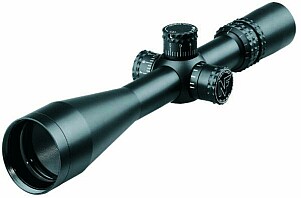
Nightforce Turret photos Courtesy ShootingTips.com, Copyright ? 2004, Satoshi Maoka. Exit pupil photo courtesy Jim De Kort, Copyright ? 2004. Contrast photos courtesy D & B Supply, Copyright ? 2004.
Copyright ? 2004, 6mmBR.com, All Rights Reserved. No reproduction without advanced permission in writing.